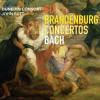Texte paru dans: / Appeared in:

Fanfare Magazine: 37:4 (03-04/2014)
Pour
s'abonner / Subscription information
Les abonnés à Fanfare Magazine ont accès aux archives du
magazine sur internet.
Subscribers to Fanfare Magazine have access to the archives of the magazine
on the net.
Linn
CKD430

0691062043021 (ID336)
This, I regret to say, comes as a big disappointment, especially after my very positive review and recommendation of a Handel Esther from John Butt and the Dunedin Consort in 36:2. Let me be blunt: the problem with these Brandenburgs is the period instruments, not all of them, just the brass. Esther, of course, called for two horns and a trumpet, but not in the starring, virtuosic roles in which Bach cast two corni da caccia in the Brandenburg No. 1 and a solo trumpet in the Brandenburg No. 2.
Listening to the set in its entirety, I couldn’t help but muse that if not for the disastrous results obtained in the first two concertos, the remaining four would be just fine, but that’s little consolation when one hears the garbling, gabbling sounds emanating from the horns in No. 1, and the forced, strained, shrill sounds coming from the trumpet in No. 2. If ever an argument to be made, I thought, for banning the use of period instruments in these two concertos, this would be it.
But one cannot place the entire blame on lifeless lumps of metal; surely, the players share some of the responsibility. On evidence of the outcome, plain for anyone to hear, the horns’ articulation of rapid notes in the First Concerto is so flabby and lacking specificity in placement of notes that passages sound like mush. The trumpet in the Second Concerto fares a bit better, but, ironically, due to the high pitch of its part and the piercing tone of the instrument, its sins are not as easily covered over by the rest of the ensemble. Most of the deficiencies involve the shmearing of notes in passages that require rapid tonguing and jittery judders pretending to be trills. On a couple of the highest notes, too, intonation is suspect.
I’m sorry, truly I am, but this is not good. It’s reminiscent of the way period instrument performances sounded 25 or 30 years ago, and it gives period instruments a bad name. As I said above, the four remaining concertos are without blemish and go well, for which reason I can only speculate that it’s because Bach didn’t write any brass parts. The Dunedin’s strings and woodwinds are excellent.
Whether your preference is for period instruments or modern, there is no shortage of Brandenburgs from which to choose. A good compromise—and one of my top choices—is Helmuth Rilling’s set of the concertos with the Oregon Bach Festival Orchestra on Hänssler. For the most part, Rilling uses modern instruments, but opts for recorders in Nos. 2 and 4 and violas da gamba in No. 6. But when you hear the clarity of the horns in No. 1 and the pristine purity of the trumpet in No. 2, you’ll understand why God created valves. This is not to say that there aren’t or can’t be superb performances by fully period instrument ensembles. One I have enjoyed immensely is Trevor Pinnock’s remake for Avie, this time with a hand-picked consort of players billed as the European Brandenburg Ensemble. Here you will experience trumpeting by David Blackadder that’s natural, assured, and relaxed sounding.
I wish I could welcome Butt and his Dunedin players into the fold, but this is a not a Brandenburg set to be greeted with huzzahs and hurrahs.
Cliquez l'un ou l'autre
bouton pour découvrir bien d'autres critiques de CD
Click either button for many other reviews


